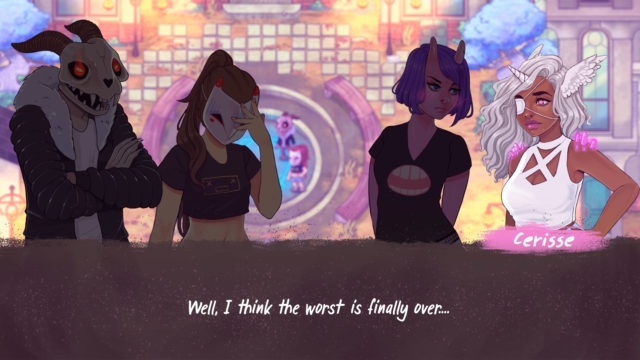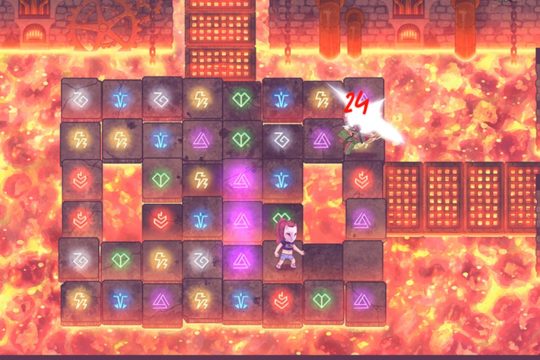Delightful combat system marries puzzle strategy with real-time dangers; great visuals; fun characters
Manga/anime tropes can wear thin; done in a flash (although it does leave you wanting more in a good way!)
The name Viz is likely to get quite a few smiles spreading across people’s faces. After all, as one of the biggest manga publishers in the world, Viz Media is synonymous with legendary series like Full Metal Alchemist, One Piece, Dragon Ball Z, My Hero Academia, and countless others— to say that the company is beloved would be an understatement. That’s why it was quite exciting when Viz announced it would be entering the world of video game publishing for the first time with the game The World Next Door.
Developed by Rose City Games, The World Next Door marks something of a sea change for Viz. While many might have expected Viz to turn to one of its longtime manga or anime franchises for its maiden voyage as a game publisher, the outfit instead opted to go the indie route and bring something wholly original to the table. While there undoubtedly might come a time when Viz brings its own spin to Dragon Ball or The Promised Neverland in video games, fans would be much worse off without The World Next Door to play.
Jun is a young girl who lives in a reality where the Earth and another planet called Emrys are joined together via portals. Originally, the two worlds would clash when the portals would open. Emrys is a place of magic while Earth isn’t all that different from our own, so their unique populations initially found themselves at odds with one another. Eventually, the fighting stopped and Earth and Emrys became peaceful towards one other. This peace has become so prevalent that when the portals open, Earth and Emrys exchange visitors and celebrate the occurrence.
For Jun, the opportunity to visit Emrys is a thrill at first, but things take a turn when she finds herself stranded on the planet. Jun must venture into dungeons to fight monsters and try to make her way back home. As far as setups go, The World Next Door wouldn’t be out of place in the pages of a manga, as it mixes magic, action, and high school drama into a single package. There’s a lot of heart on display in both the narrative as well as the design work by illustrator Lord Gris. Fans of the sorts of stories that Viz is so famous for will likely find plenty to love in The World Next Door.

The game world, particularly the dungeons, are evocative of The Legend of Zelda. With a fixed, top-down perspective and dungeons to explore, there are certainly some similarities between the realms of Link and Jun. Yet, mechanically, the two franchises are poles apart. Combat in The World Next Door is rooted in match-three puzzle gameplay. When battles initiate, the floor is illuminated with tiles bearing a variety of symbols. Jun must walk across them to connect three, which will then grant her a spell to use offensively or for healing.
It’s an immensely satisfying method of fighting. Comparisons have been drawn to battling in The World Next Door and games like Puzzles and Dragons, which is fair but also leaves out some crucial details. For one thing, players can choose who to take into dungeons; these selections matter because allies have a variety of special abilities to take advantage of. Additionally, linking tiles takes place while also trying to avoid incoming attacks from enemies. This deadly dance of evading harm and trying to chain together the components to cast a spell is intoxicating in its elegance and very satisfying to pull off.

When not fighting baddies, Jun is getting to know the world of Emrys and her new friends. It’s in these interactions that The World Next Door’s manga/anime tropes become most readily apparent, but it’s an aspect of the game that can be as divisive as it can be endearing. All manga and anime are not the same, of course, but there do tend to be familiar character types and story beats that crop up frequently in both. While some fans love the familiarity that this can foster, there are others who consider it rote. As someone who enjoys manga but isn’t an avid reader of it, I found the characterizations and interactions between characters fun, but occasionally cliché. Still, overall this is solid writing and I feel that more players will enjoy Jun and company versus not.
If there’s any other significant complaint to levy against The World Next Door, it would be that it’s so short. Duration of a game is always tricky to weigh in a review: there’s no set number of hours that a game has to be, after all, so saying a title is or isn’t too long is frustratingly subjective and hard to convey to other people. What I can say is that The World Next Door is so unique and entertaining that it’s a shame to see Jun’s adventure come to a close when it does. Rose City Games seems to be intent on making The World Next Door even better in the future, so there’s hope that if enough people take a shine to the game it’s possible another could come in the future. I highly recommend that you give some thought to being one of those fans who gives The World Next Door some support. It isn’t a perfect game and it could stand to be longer, but for what it is, I have confidence that Viz is on the right track as a game publisher and can’t wait to see what it next brings to Switch.
Nintendojo was provided a copy of this game for review by a third party, though that does not affect our recommendation. For every review, Nintendojo uses a standard criteria.




 ShareThis
ShareThis





